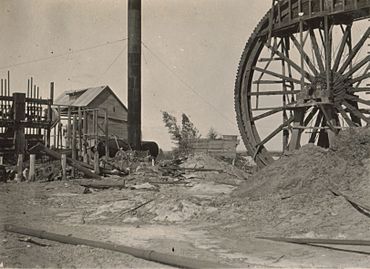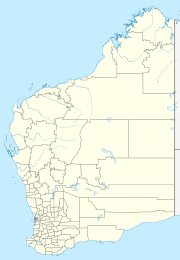Comet Vale, Western Australia facts for kids
Quick facts for kids Comet ValeWestern Australia |
|
|---|---|

Old Gladsome Mine, Comet Vale, Western Australia, ca. 1928
|
|
| Established | 1916 |
| Postcode(s) | 6438 |
| Elevation | 386 m (1,266 ft) |
| Location |
|
| LGA(s) | Shire of Menzies |
| State electorate(s) | Electoral district of Kalgoorlie |
| Federal Division(s) | O'Connor |
Comet Vale is an abandoned town in Western Australia. It's located in the Goldfield region. You can find it between the cities of Kalgoorlie and Laverton on the Goldfields Highway. The town is part of the Shire of Menzies.
Contents
The Story of Comet Vale
How Comet Vale Got Its Name
The town was named after a comet that was visible in the sky. This happened around the same time that gold was first discovered in the area.
Early Days and Growth
By 1895, Comet Vale had about 500 people living there. The town grew quickly. By 1897, people living in Comet Vale wanted their own post office. The head postmaster then told the post offices in Menzies and Goongarrie to send mail bags to Comet Vale every day. These mail bags were then given out at one of the local stores.
The Comet Vale Hotel was built before 1898. This shows that the town was becoming a real community. The government officially recognized Comet Vale as a town in 1916.
Gold Discovery and Mines
A prospector named Dan Baker is known for finding the first gold in Comet Vale. By 1900, two mines were already working: the Lady Margaret and the Long Tunnel.
Another mine, the Gladsome, started operating before 1905. The Moss brothers also built a large machine called a 10-head stamp mill at Coonega in Comet Vale. This machine helped crush rocks to get the gold out.
More mines opened later. These included the Sand Queen and Happy Jack mines. Both of these mines continued to work even after World War I ended.
Town Services and Water
A police station was set up in Comet Vale, but it was destroyed in 1916. A coach service used to travel to the town. It came from Goongarrie and continued on to the Ularring district. This coach helped people travel and send goods.
In 1921, something important happened. Fresh water was found in old mine shafts not far from the town. Before this, water had to be brought in by train all the way from Kalgoorlie. Finding local water was a big help for the town.


